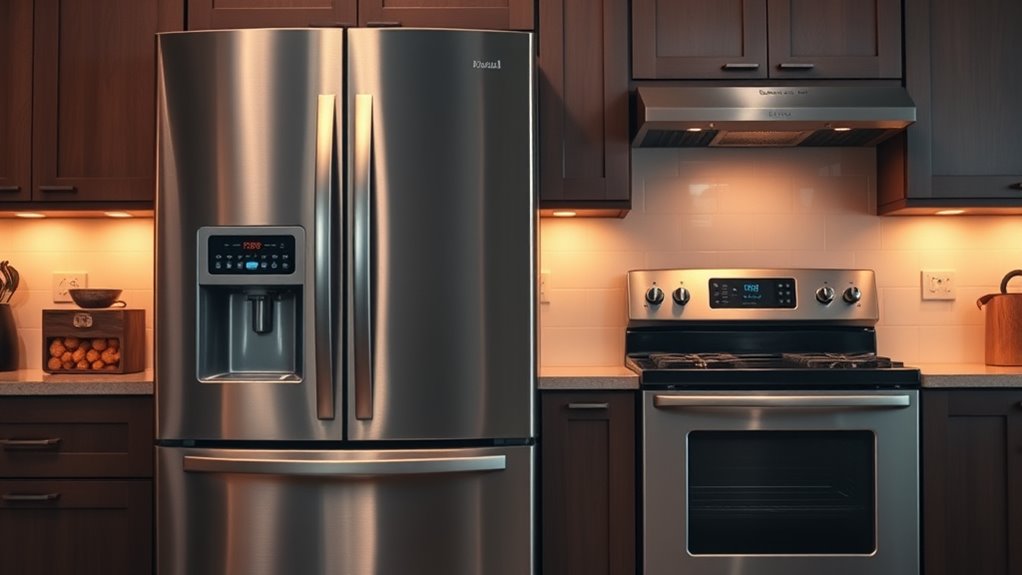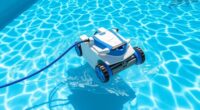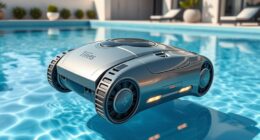Smart appliances often have shorter lifespans than traditional models because their complex electronics and software make them more sensitive to environmental factors and potential failures. However, recent innovations like predictive diagnostics, modular designs, and advanced materials aim to boost their durability. Proper maintenance, usage habits, and support options also play a role. To understand how these factors influence longevity and what’s on the horizon, explore further to get detailed insights.
Key Takeaways
- Smart appliances often have shorter lifespans due to delicate electronic components and environmental sensitivities.
- Traditional models tend to be more durable, utilizing robust materials and mechanical parts designed for longevity.
- Proper maintenance tailored to each type, such as software updates for smart devices and mechanical inspections for conventional ones, extends lifespan.
- Advances in AI, modular design, and durable materials are improving the longevity of smart appliances.
- Usage patterns and operating environments significantly influence the comparative durability of both smart and traditional appliances.
Understanding the Basics of Appliance Durability
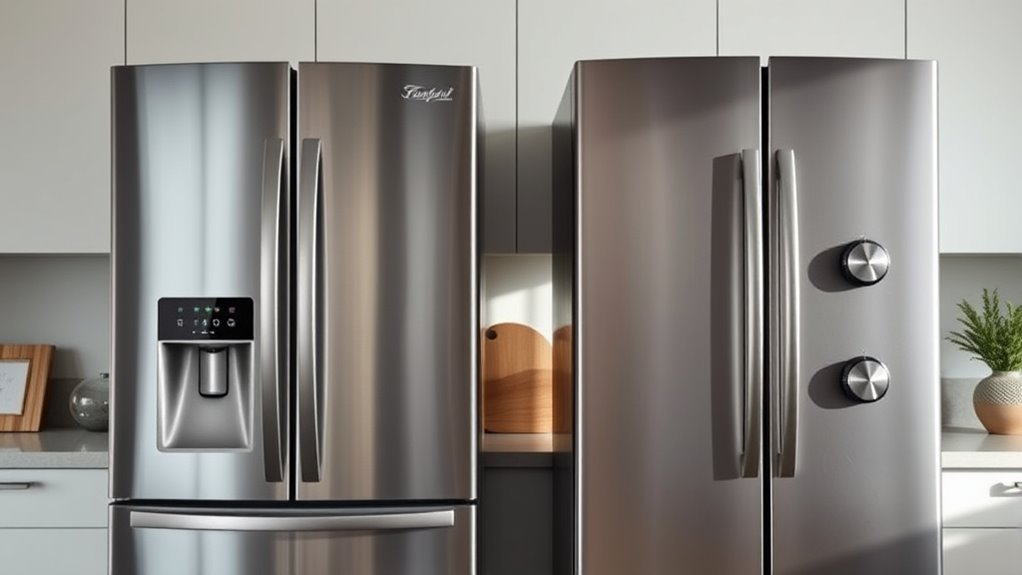
Understanding how long your appliances last begins with recognizing the key factors that influence durability. The first is the quality of components used during manufacturing. Higher-quality parts tend to withstand wear and tear better over time. Second, proper maintenance plays a vital role; regular cleaning and timely repairs prevent small issues from escalating. Usage patterns also matter—frequent or heavy use can accelerate wear. Additionally, the environment where the appliance operates affects its lifespan; extreme temperatures or humidity can cause damage. Finally, technological complexity can influence longevity; simpler models often have fewer breakdown points, while advanced features may introduce potential failure points. Recognizing these factors helps you better evaluate and care for your appliances, whether traditional or smart, ensuring they serve you well longer. Understanding appliance durability is essential for making informed purchasing decisions and extending the lifespan of your devices. Furthermore, staying informed about the latest innovations in smart appliance technology can help you choose models designed for longer service life and better resilience. Being aware of the components used during manufacturing can also guide you in selecting appliances with durable parts. Additionally, monitoring and AI security vulnerabilities in smart appliances can help prevent unexpected failures and security breaches.
Material Quality and Build Standards in Traditional vs. Smart Devices
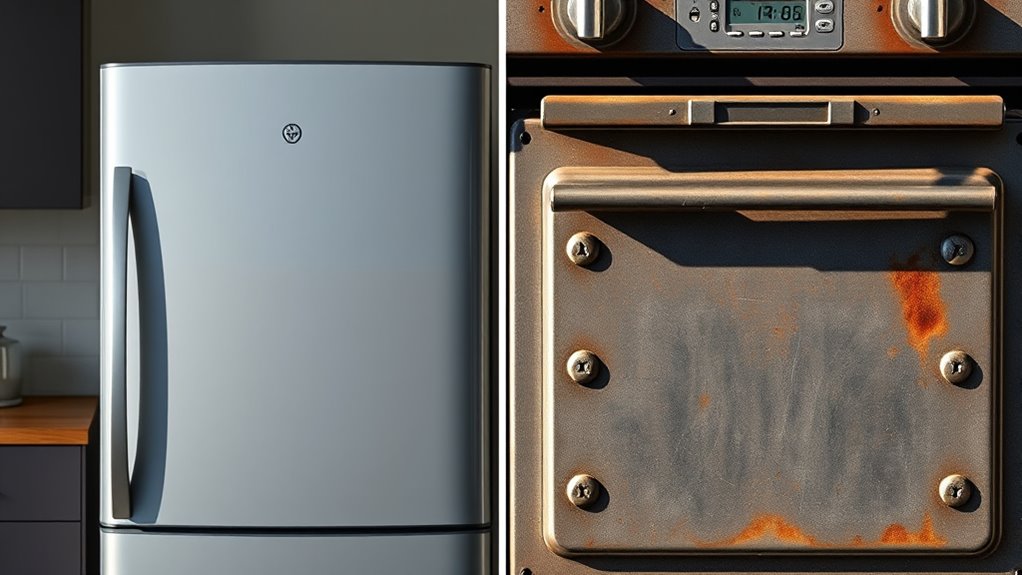
You might notice that smart devices often use different materials and components than traditional appliances, affecting their durability. Higher standards for material quality can lead to longer-lasting products, but not all smart devices meet these benchmarks. Comparing component durability and material standards helps you understand which appliances are built to last. Additionally, selecting appliances with comprehensive emergency preparedness features can enhance their resilience in unexpected situations. Incorporating goal setting practices when choosing devices can also ensure your selections align with long-term reliability and efficiency goals. Furthermore, understanding hackathons can offer insights into innovative solutions and emerging technologies that influence appliance development. Recognizing the importance of cultural heritage in appliance design can help you select models that respect traditional craftsmanship while offering modern durability. Understanding the contrast ratio of home appliances and projectors can further inform your choices, as higher contrast ratios often indicate better performance and longevity.
Component Durability Differences
While both traditional and smart appliances rely on various components to function, their material quality and build standards often differ markedly. Smart devices tend to use more complex, delicate parts like sensors, circuit boards, and miniature actuators, which can be more prone to failure if not made with high-quality materials. Traditional appliances, on the other hand, often feature thicker, more robust components designed for durability. Smart components are sensitive to environmental factors like moisture and temperature. Lower-quality parts can lead to quicker failures in smart devices. Additionally, the security vulnerabilities associated with smart devices can impact their overall reliability and lifespan. The presence of software updates can also influence the longevity of smart appliances, sometimes introducing new issues or incompatibilities over time. Understanding these differences helps you gauge which appliance might last longer under typical usage and maintenance conditions. Furthermore, quality control standards play a significant role in determining the durability of each type of appliance, influencing how well they stand up to regular use over time. Additionally, the materials used in manufacturing smart devices can vary widely, affecting their overall resilience and longevity.
Material Quality Standards
Traditional appliances typically adhere to established material quality standards that emphasize durability and longevity, using thicker metals, heavy-duty plastics, and robust mechanical parts. These choices ensure the appliance withstands daily wear and tear over many years. In contrast, smart devices often prioritize sleek design and compactness, which can lead to lighter, less durable materials. While manufacturers may use high-quality plastics and metals, they sometimes sacrifice thickness or robustness for aesthetics and technology integration. This difference impacts long-term resilience; traditional appliances are less prone to damage from impacts or heavy use. Smart appliances, although built with good materials, sometimes rely on sensitive electronic components that may not endure as well under rough handling or extended use. Additionally, the emphasis on material robustness in traditional products contributes significantly to their extended lifespan compared to many smart models. The focus on durability ensures traditional appliances can often be repaired or maintained more easily over time, prolonging their usability and reducing the need for replacements. Moreover, traditional appliances typically undergo more rigorous testing for mechanical stress and environmental factors, further enhancing their longevity.
The Role of Technology and Software in Smart Appliance Lifespan
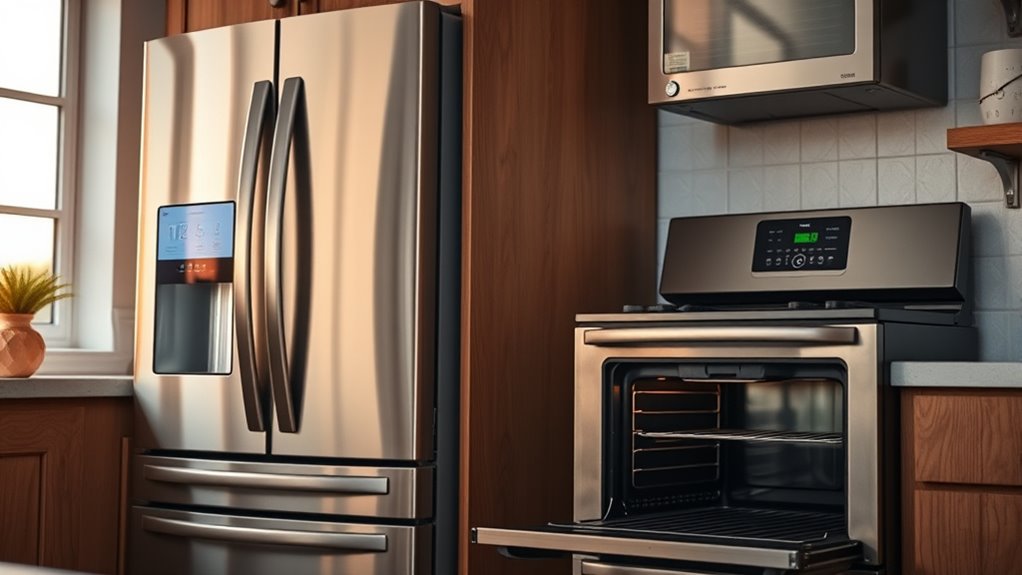
Advancements in technology and software have become essential factors in extending the lifespan of smart appliances. They enable real-time diagnostics, automatic updates, and adaptive performance, which help prevent failures before they happen. When software regularly updates, it patches vulnerabilities and improves efficiency, reducing the risk of malfunctions. Additionally, smart appliances learn from your usage patterns, optimizing operations to lessen wear and tear.
- Continuous software updates fix bugs and improve functionality
- Predictive analytics forecast potential issues early
- Firmware improvements enhance hardware longevity
- Integration with smart home systems allows better monitoring and control
These technological features keep your appliances running smoothly longer, preventing premature breakdowns and ensuring they stay relevant in a rapidly evolving digital landscape.
Maintenance and Upkeep: Differences for Smart and Conventional Models

Smart appliances often require different maintenance than conventional models, with regular software updates replacing some mechanical repairs. You might find that keeping your smart device running smoothly involves monitoring both hardware and digital components, which can affect upkeep costs. Understanding these differences helps you plan for routine care and budget accordingly. Additionally, staying informed about digital health can help prevent potential issues before they become costly. Regularly reviewing your appliance’s operational status can also extend its lifespan and ensure optimal performance. Incorporating preventive maintenance practices tailored to smart devices can further enhance longevity and reliability. Being aware of manufacturing quality can also influence your expectations for durability and long-term use. Properly managing software updates can prevent security vulnerabilities and improve device functionality over time.
Routine Maintenance Needs
While both smart and conventional appliances require regular maintenance to stay in good working order, the nature of their upkeep differs markedly. Smart appliances often need software updates and connectivity checks, ensuring they function seamlessly with your home network. Conventional models mainly require mechanical inspections and cleaning to prevent breakdowns.
Consider these key differences:
- Regularly updating firmware on smart devices
- Monitoring Wi-Fi or Bluetooth connectivity
- Cleaning filters and vents in traditional appliances
- Checking mechanical parts for wear and tear
- Keeping firmware current supports appliance longevity and optimal performance. Additionally, smart appliances may utilize digital diagnostic tools that help identify potential issues before they become serious.
Smart appliances rely on digital health checks, while conventional models depend on physical inspections. Understanding these needs helps you keep both types running efficiently and extend their lifespan. Proper maintenance tailored to each model ensures you get the most out of your investment.
Software vs. Mechanical Repairs
When it comes to repairs and upkeep, smart appliances primarily require software fixes and updates, whereas conventional models depend on mechanical repairs. Software issues, like bugs or outdated firmware, can often be addressed remotely or through simple updates. Mechanical repairs, on the other hand, involve replacing parts or fixing hardware components, which can be more time-consuming and costly. This difference impacts maintenance frequency and skill requirements. Additionally, understanding eye patch benefits can be helpful for those using eye patches as part of their skincare routine, highlighting the importance of proper care and maintenance. Moreover, the security of smart systems plays a role in ensuring reliable operation and protection against cyber threats, which can influence long-term appliance durability. Regular system updates are crucial to maintain optimal performance and security. In contrast, traditional models typically demand more hands-on hardware repairs, emphasizing the value of skilled technicians.
Upkeep Cost Differences
Upkeep costs for smart appliances tend to be lower overall compared to conventional models, mainly because software updates and remote troubleshooting reduce the need for costly, hands-on repairs. You save money on service calls and parts, as issues can often be diagnosed and fixed remotely or with simple updates. Additionally, smart appliances typically come with preventative maintenance alerts, helping you address minor problems before they escalate. Keep in mind, however, that smart devices may have higher initial costs for parts like sensors or modules, which might need replacement over time. To maximize savings, consider these factors:
- Fewer emergency repairs due to early diagnostics
- Reduced labor costs with remote fixes
- Lower likelihood of major breakdowns
- Ongoing software updates extend device lifespan
Common Causes of Appliance Failure and How They Differ
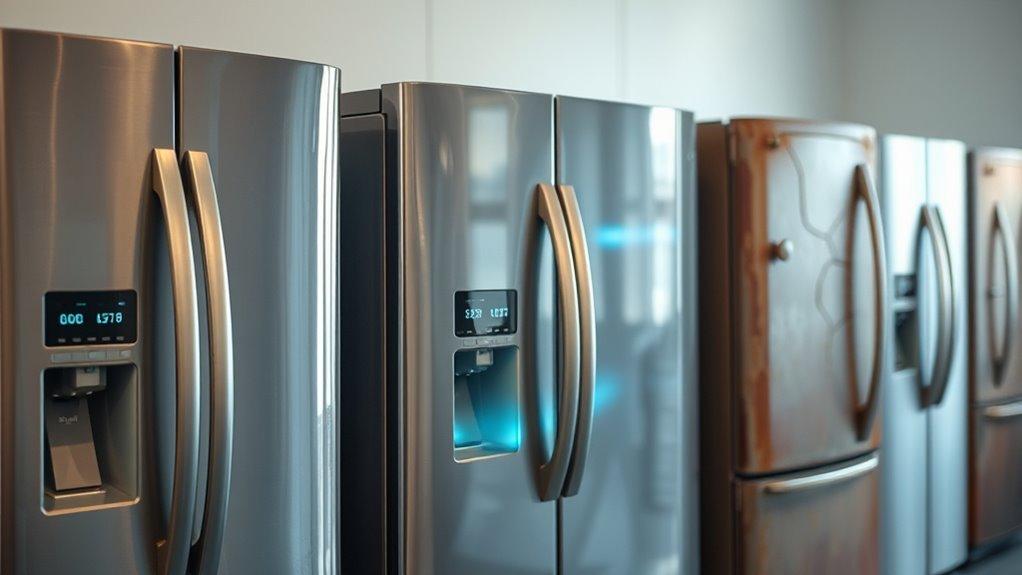
Understanding the common causes of appliance failure is key to preventing unexpected breakdowns and extending their lifespan. For traditional models, issues often stem from worn-out parts, such as motors, belts, or filters, which degrade over time due to regular use. Electrical problems, like faulty wiring or blown fuses, also contribute to failures. Smart appliances, however, tend to fail due to software glitches, connectivity issues, or sensor malfunctions. While both types can experience mechanical wear, smart models face additional risks from cybersecurity vulnerabilities or firmware corruptions. Unlike traditional appliances, smart devices rely heavily on electronic components and network connections, making them susceptible to digital failures. Recognizing these differences helps you anticipate potential issues and take proactive steps to maintain your appliances effectively.
Impact of Usage Patterns on Longevity
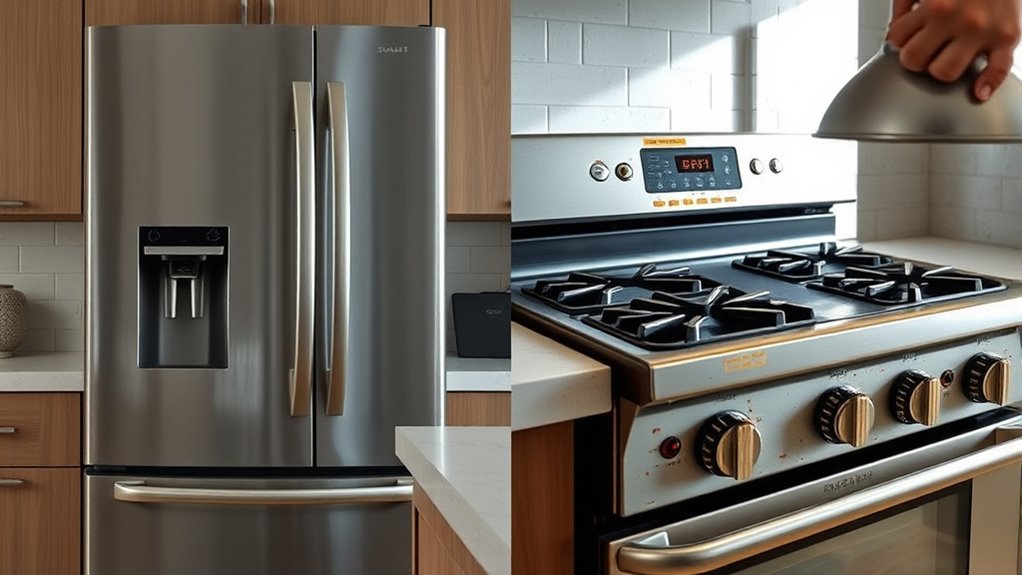
Your usage patterns play a crucial role in determining how long your appliances last. How often and how you operate them directly impacts their lifespan. Frequent, heavy use can accelerate wear and tear, while inconsistent operation may cause unnecessary stress on components. Properly managing settings and avoiding overloading can extend their longevity. Additionally, regular maintenance, like cleaning filters or checking connections, helps prevent breakdowns caused by usage habits. Keep in mind that smart appliances often require specific usage care to maximize efficiency and lifespan.
- Using appliances at recommended settings reduces strain
- Avoiding rapid cycling prevents component stress
- Regular maintenance mitigates buildup or damage
- Spreading out usage avoids overloading specific parts
Manufacturer Warranties and Support for Different Appliance Types
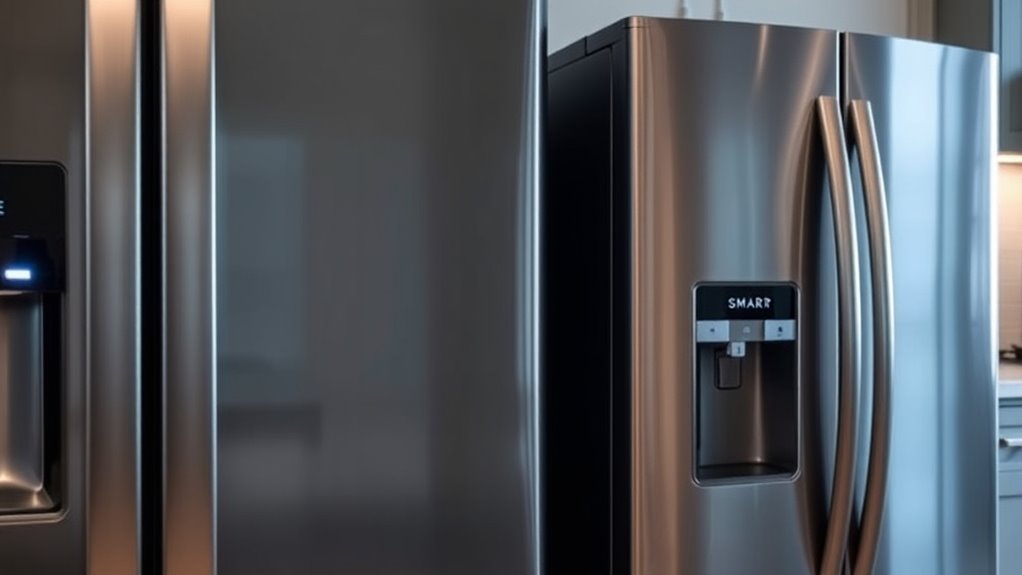
Manufacturer warranties and support policies vary widely depending on the appliance type, offering a vital safety net for consumers. For traditional appliances, warranties typically last one to two years, covering parts and labor for repairs. Smart appliances often come with similar or slightly longer warranties, but they may also include tech support and software updates. Some manufacturers extend support for smart models due to the complexity of their electronics and connectivity features. Keep in mind that warranty coverage can differ markedly between brands and product lines. Additionally, support services like customer assistance, remote diagnostics, and firmware updates are often more accessible for smart appliances, enhancing their overall reliability. Understanding these policies helps you make informed choices and guarantees you’re protected against unexpected issues.
Cost of Repairs and Replacement Considerations

When a smart appliance breaks down or becomes outdated, the costs to repair or replace it can vary considerably, impacting your overall budget. Repair costs for smart devices often include specialized parts and expert labor, which tend to be higher than traditional models. Replacement expenses can be steep, especially if the appliance is outdated or no longer supported. You should consider:
- The expense of repairing advanced tech components
- The potential for frequent repairs with cheaper parts
- The savings from replacing old models with newer, more efficient ones
- The impact of warranty coverage on repair costs
Understanding these factors helps you weigh whether fixing an appliance is worth the investment or if replacement makes more sense financially. Being informed ensures you avoid unexpected expenses and make smarter choices.
Future Trends and Innovations Affecting Longevity
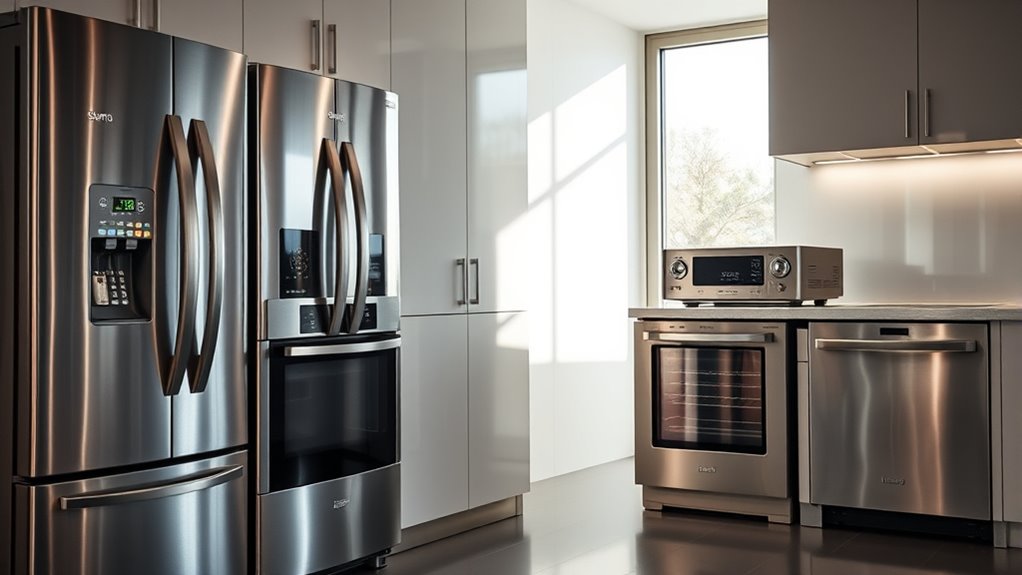
Advancements in technology are driving the development of smarter, more durable appliances that are built to last longer. Future trends include the integration of AI and machine learning, which enable appliances to anticipate issues and optimize performance proactively. Innovations like self-diagnosing systems will reduce downtime and extend lifespan by catching problems early. Materials are also evolving, with improved corrosion-resistant and heat-resistant components enhancing durability. Additionally, modular designs are emerging, allowing you to replace individual parts instead of entire units. Smart diagnostics and remote monitoring will help you maintain appliances more effectively, preventing premature failures. These trends aim to increase longevity while making appliances more efficient and user-friendly, ensuring you get more value and reliability from your investment over time.
Frequently Asked Questions
Do Smart Appliances Tend to Last Longer Than Traditional Models?
You might wonder if smart appliances last longer than traditional ones. Generally, smart appliances can have similar or slightly shorter lifespans due to their complex electronics and software. However, their advanced features often mean quicker upgrades or repairs. Proper maintenance helps extend their lifespan. While they offer convenience, don’t forget that traditional models are often more durable and easier to repair, which can lead to a longer overall life.
How Does Software Updates Affect Smart Appliance Lifespan?
Software updates can extend your smart appliance’s lifespan by fixing bugs and improving performance. However, if updates become incompatible or stop supporting your device, it might cause issues or even shorten its usability. You should regularly update your appliance and stay informed about support policies. Doing so helps you maximize longevity, but be aware that outdated software or lack of updates can also lead to faster obsolescence.
Are Smart Appliances More Susceptible to Obsolescence?
You might wonder if smart appliances become outdated faster than traditional ones. Because smart appliances rely on software and internet connectivity, they are indeed more susceptible to obsolescence. Software updates can become unsupported over time, and new technology may render your device less functional or incompatible. This means you’ll need to replace or upgrade smart appliances sooner, whereas traditional models typically last longer without becoming obsolete due to software limitations.
What Are the Environmental Impacts of Replacing Smart vs. Traditional Appliances?
Think of your appliances as the heart of your home’s ecosystem. When you replace smart appliances, you might save energy but create electronic waste faster, straining the environment. Traditional models often last longer, reducing waste. If you switch to smart devices frequently, you risk accelerating environmental damage. Balancing technology’s benefits with eco-conscious choices helps protect our planet, ensuring your home’s heartbeat stays steady and sustainable.
Can Smart Appliances Be Repaired Easily Compared to Traditional Ones?
You might wonder if smart appliances are easier to repair than traditional ones. Generally, traditional appliances are simpler with fewer electronic parts, making repairs more straightforward and often cheaper. Smart appliances, however, require specialized skills and tools for troubleshooting due to their advanced technology and software. While some repairs are manageable if you’re tech-savvy, many repairs may need professional service, which can be more complicated and costly compared to traditional models.
Conclusion
Just like a well-tended garden blooms longer, your appliance’s lifespan depends on quality, maintenance, and smart usage. While traditional models often focus on sturdy materials, smart appliances rely on advanced technology that can both extend or shorten their longevity. By staying proactive with upkeep and choosing reputable brands, you can enjoy your devices for years. Remember, understanding these differences helps you make smarter choices, so your appliances serve you well, like a loyal friend through the years.
